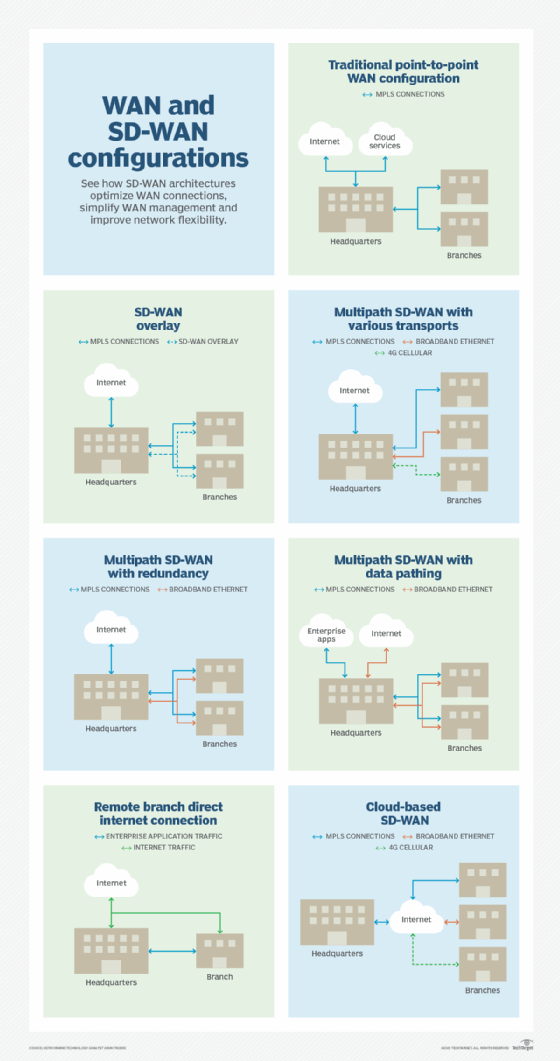
WavebreakMediaMicro - Fotolia
How SD-WAN architectures improve network flexibility and efficiency
The key benefits of SD-WAN architectures include better network redundancy, efficient MPLS connections and added flexibility to deploy new services remotely.
A WAN connects multiple business locations, like a headquarters and branch offices, providing a point-to-point private network that enables the locations to share applications and data.
WAN management is traditionally handled through WAN endpoints and is quite complex. With a software-defined WAN (SD-WAN), a centralized controller and a software overlay handle WAN management. SD-WAN architectures are an attractive option, as the deployment, configuration and management of remote links can be greatly improved, with some even offering zero-touch provisioning.
As businesses move to SD-WAN architectures, initially, most will simply add the software overlay on top of the existing WAN connections. But, over time, because of the easily configurable capabilities of SD-WAN architectures, businesses will start to adopt SD-WAN's more complex capabilities.
Historically, WAN connections were built on multiprotocol label switching (MPLS), a more expensive technology with limited bandwidth but excellent quality of service (QoS). Knowing that most WAN traffic is of low value -- such as web content, file sharing and email -- these expensive links are often wasted on higher volume traffic that does not require high QoS. Additionally, all branch office data is backhauled in each direction over the WAN, increasing cost and latency.
Moving this data off MPLS links reduces the transport cost of the data and frees up bandwidth for more critical applications.
Much can be done with an SD-WAN architecture to optimize WAN connections.
Dissecting different SD-WAN architectures
An SD-WAN is not designed to carry or route data. Its primary responsibility is to maintain the configuration and management of the WAN points. The key benefits that a business will find when deploying an SD-WAN include better efficiency for its MPLS connections, more flexibility for deploying new services remotely and better redundancy -- all with little incremental cost.
A traditional WAN connects remote offices to a headquarters, typically with point-to-point MPLS connections. An SD-WAN is configured as a software overlay to the existing WAN, providing centralized management and configuration functionality.

An SD-WAN can use multiple transports, giving it a tremendous amount of flexibility, enabling remote endpoints that can be configured for MPLS, broadband Ethernet, 3G/4G cellular and more. This transport flexibility makes it easier to connect branches, regardless of their physical location or any carrier restrictions.
SD-WAN also makes it easier to connect multiple transports on a WAN connection, enabling redundancy. If a primary transport path fails, all traffic can be moved automatically to the remaining path, enabling continuous connectivity. The second path can be active with load balancing or lie dormant as a backup waiting for the primary to fail.
Manage transport costs more effectively
With path control, an administrator can determine which traffic will be handled by which transport. For instance, administrators could route all priority application traffic over MPLS -- for the best quality connection -- and all lower priority web traffic over broadband internet for the most cost-effective handling. By controlling the path, administrators can manage overall transport costs more effectively.
With point-to-point configurations, all inbound and outbound internet requests from branch offices are backhauled, meaning they must pass through the headquarters first. This enables the business to manage security and access for all internet traffic. The cost and complexity mean this point-to-point configuration is a single connection.
SD-WAN makes it far easier to add a second connection that allows direct internet routing for internet traffic while internal enterprise applications are still routed to headquarters. The SD-WAN can help provide the same degree of management and security that would normally be achieved via backhauling, but without the latency and congestion.
Cloud-enabled SD-WAN configuration
All the configurations to this point have relied on the headquarters managing the connections to remote branches via an SD-WAN controller at headquarters. But another connection option is available.
Several companies offer cloud-based SD-WAN where connections for both the data and the management or policy enforcement are maintained through a cloud-based controller. By removing the point-to-point connections, businesses can enable more flexible connectivity to match their needs and reduce overall costs.
Cloud-based SD-WAN provides a cloud-focused access model instead of a headquarters-focused access model, making it more in line with the direction in which many businesses are moving now.
These configurations, as detailed in the accompanying infographic, merely scratch the surface of SD-WAN's capabilities. As SD-WAN architectures become more prevalent in businesses, we'll see even more interesting configurations that can capitalize on these capabilities.








